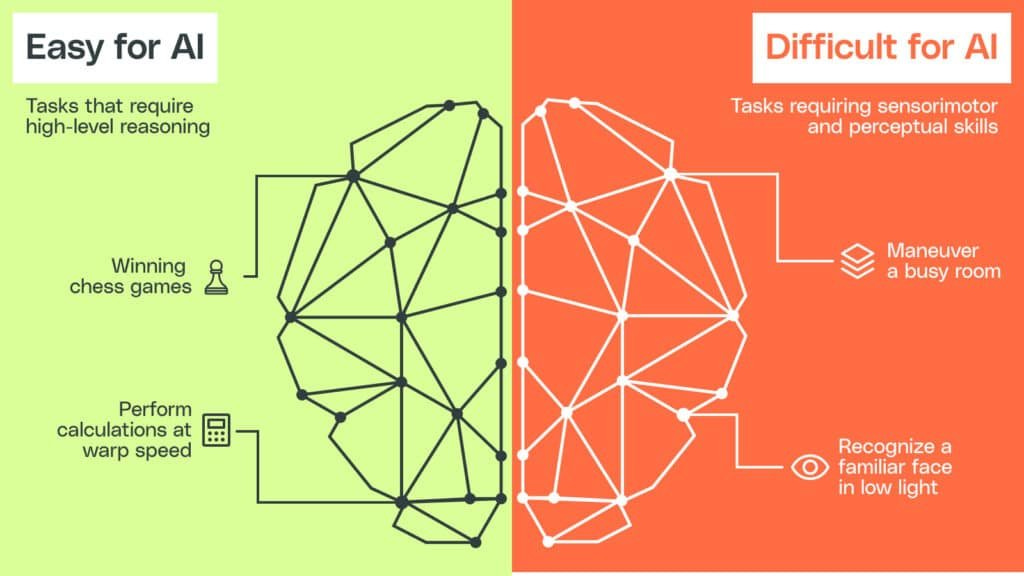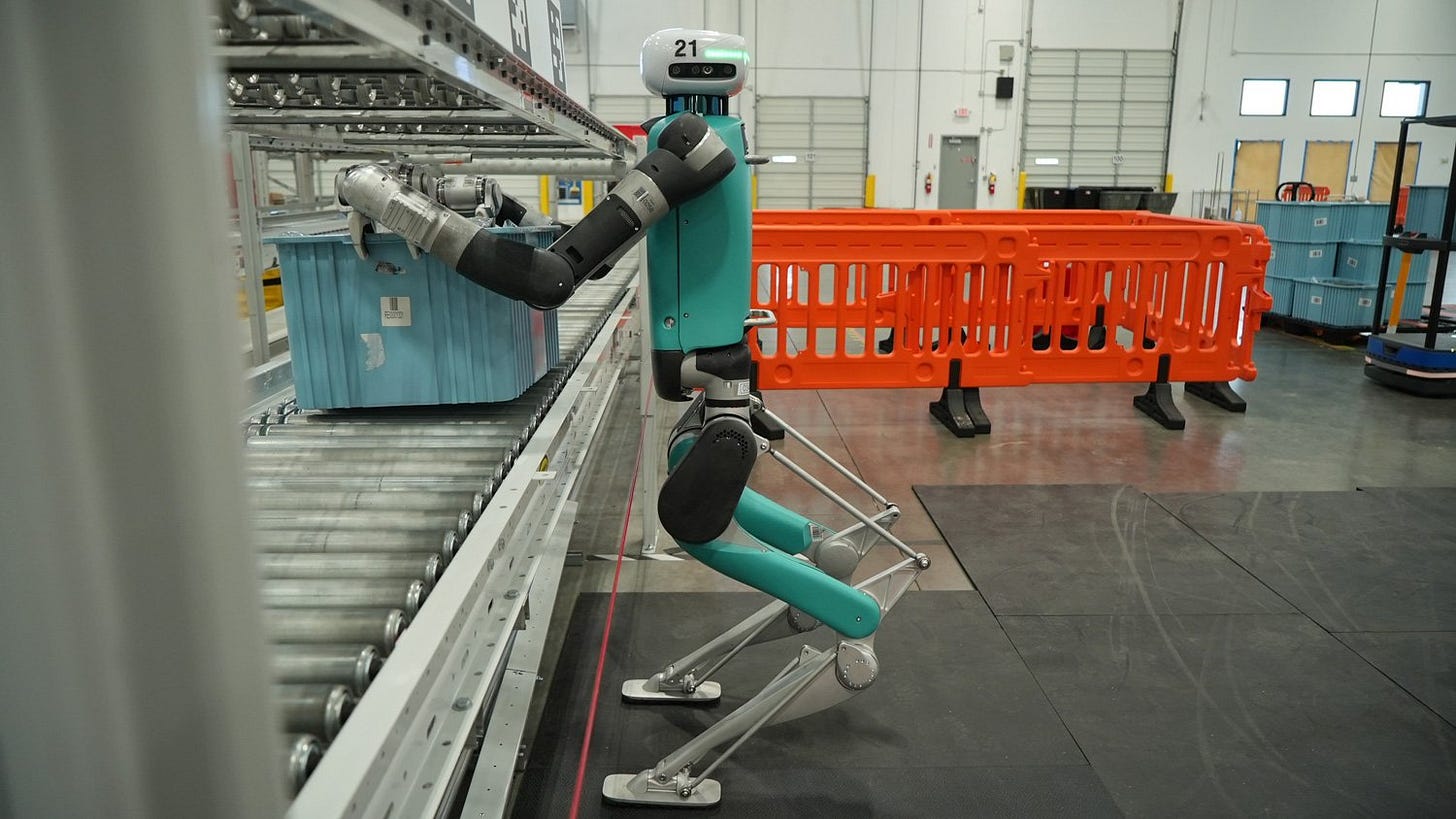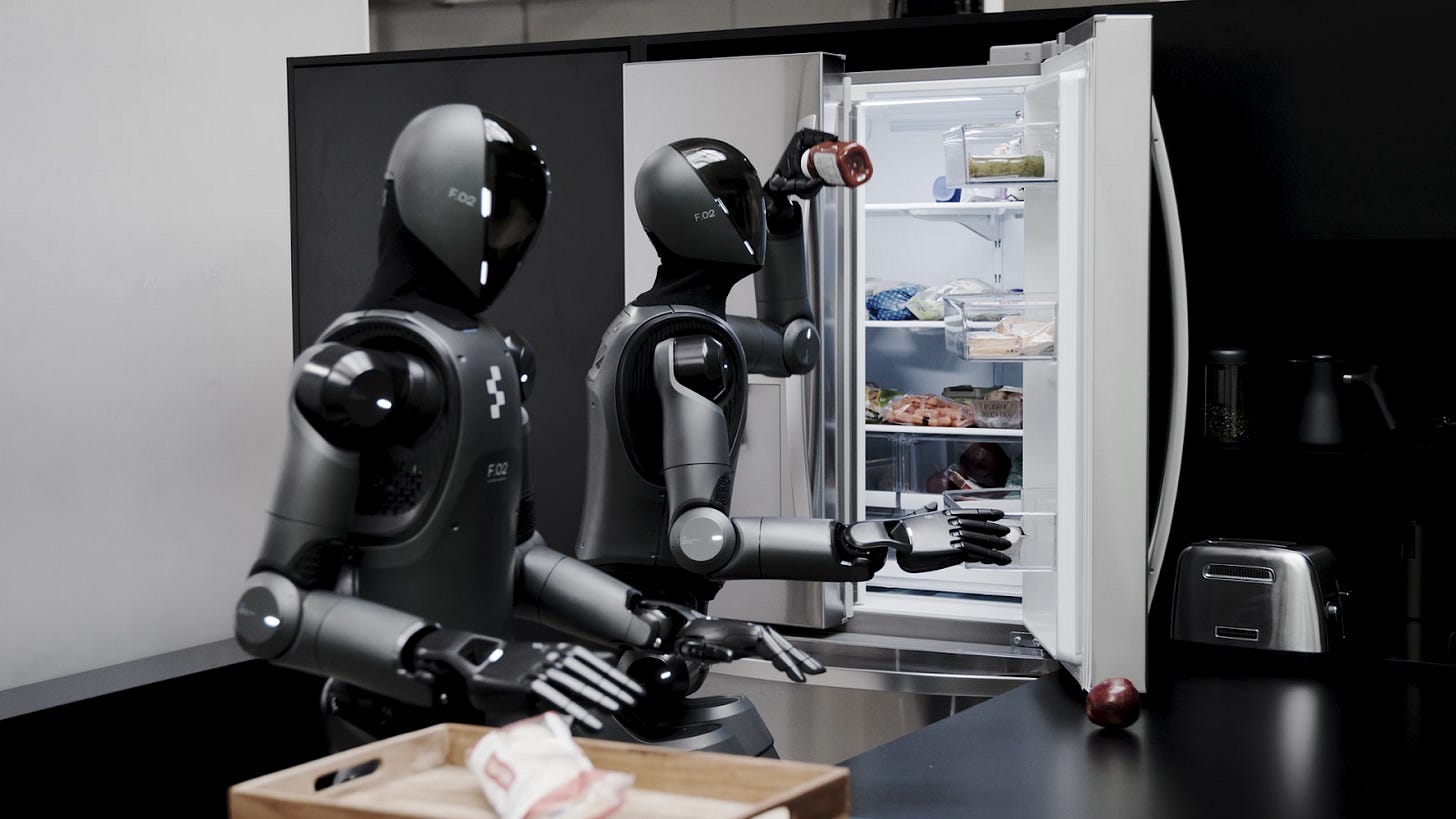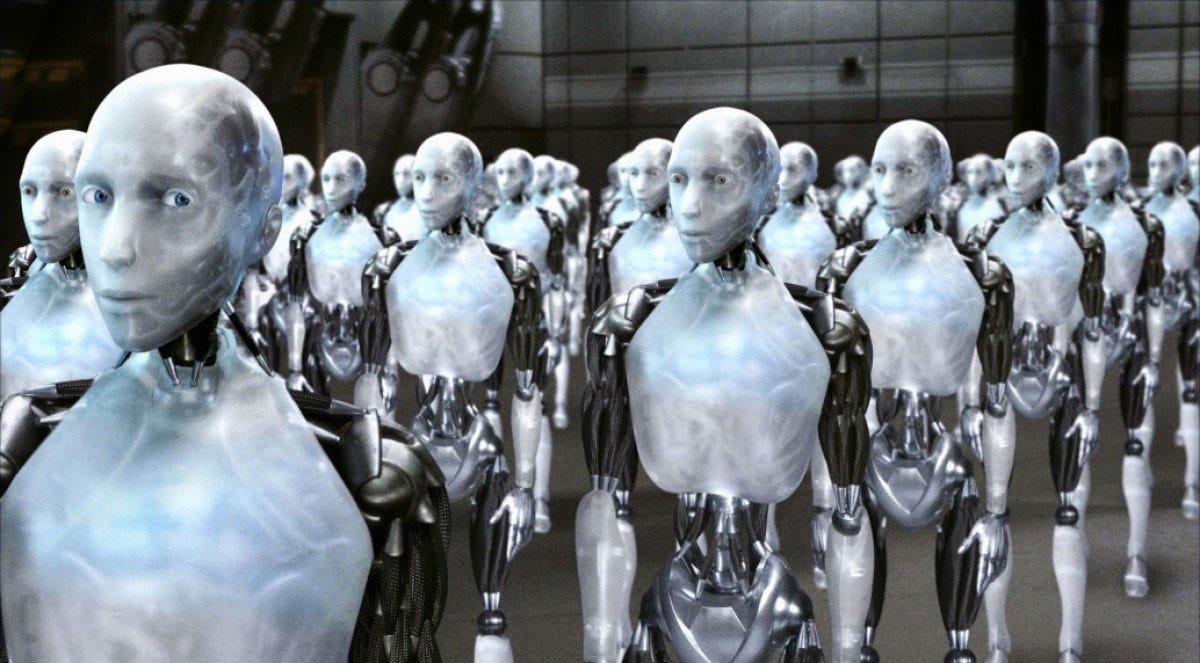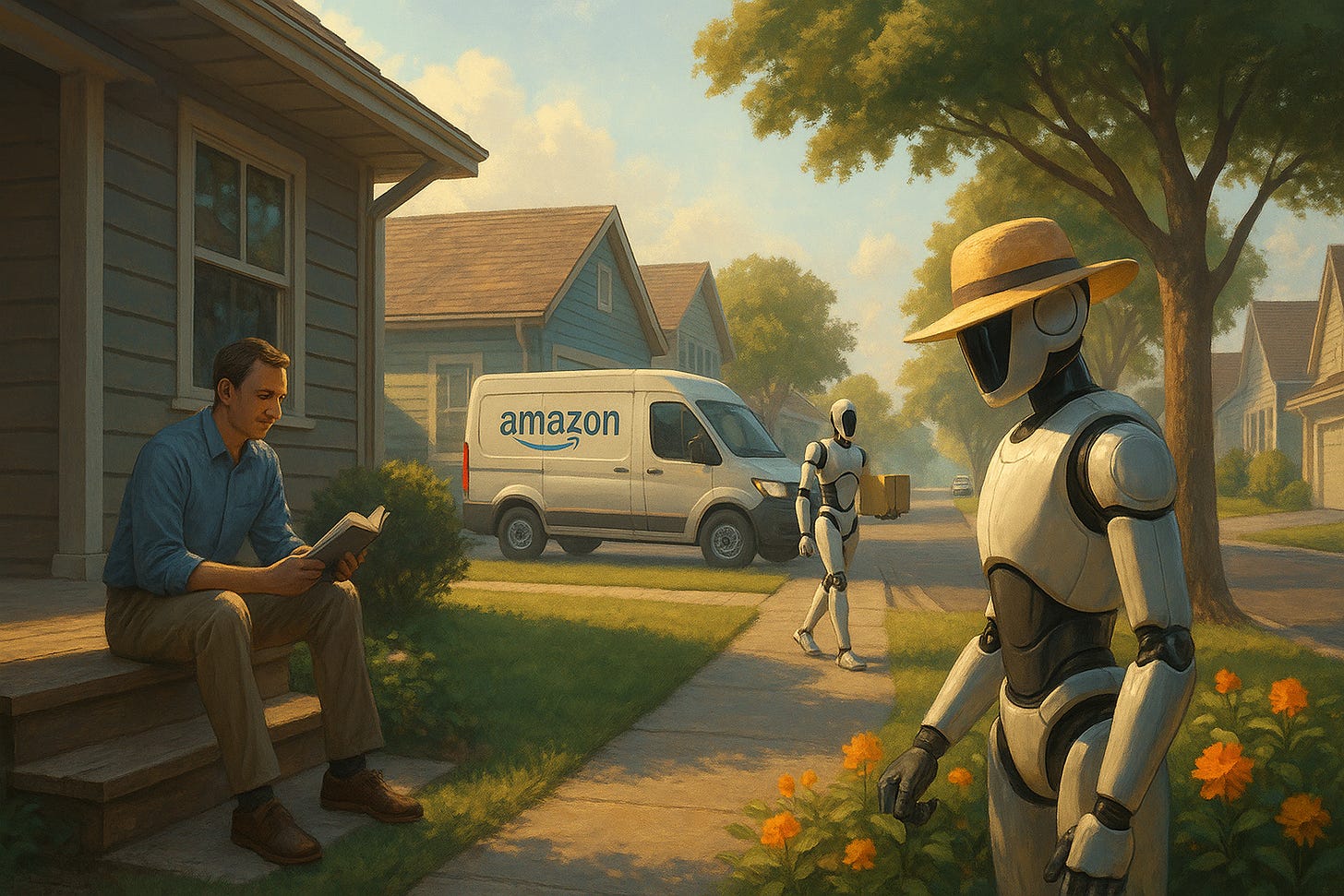The Humanoid Century Begins
A realistic timeline for when humanoid robots leave the lab and enter your life.
The year is 2043, and you’re visiting your extended family for the holidays. They live in an exceedingly normal suburb located on the outskirts of a mid-sized American city. You’ve woken up before the rest of the family and decide to take a walk in the neighborhood.
You step outside. Nothing feels out of the ordinary. The suburb looks like all suburbs: bland, with cookie-cutter houses and the same architectural design copy-pasted repeatedly. There’s a sidewalk, and the roads are nothing to write home about. A few cars pass by and you think nothing of it. As you turn a corner, a fully autonomous Amazon truck is making a delivery: the car drives itself, and a bipedal humanoid robot is returning from dropping off a package at the front door. You don’t wave at the robot, and it barely acknowledges your presence as you walk by. You’ve seen this so many times that you’re entirely unfazed.
As you finish your morning walk and loop back around to your family’s house, you spot the next-door neighbor’s yardkeeping robot finishing up tending to the garden. You notice the robot’s signature yellow hat, and realize they use the same pay-per-month automated lawncare service that you do. After all, it makes more sense to service your lawn when you need it, and owning a robot explicitly for lawn care would be silly.
The walk ends much like it begins: a pretty uneventful morning in middle America. You decide to sit down on the front porch to read a book after grabbing a cup of coffee. Yes, the book is made of paper.
Chasing the Humanoid Dream
Welcome back, dear reader.
Much like with AI, robotics hype is making major headlines this year. Companies like Figure, Tesla, and Agility are making visually impressive humanoid robots. But frankly, I’ve felt somewhat disenchanted by progress in the humanoid robotics space over the last decade, and it can be difficult to separate hype from reality.
At times, it feels like we’re stuck on a loop for meaningful progress. A decade ago, Boston Dynamics’ Atlas was showcased by the company as an electrically powered and hydraulically actuated warehouse worker. This version of Atlas was never intended to be sold to companies or used in actual warehouses, but the demo was nonetheless impressive. The LIDAR and actuators in the 2014 Atlas were as remarkable then as they are now, and led to an all-electric model that the company revealed in 2024.
In this article, we’re going to dive into why humanoid robots matter, what they’re currently good at, and when we can reasonably expect to see them commercialized and utilized by regular people. Will breakthroughs in AGI be the quantum leap we need to go from endless product demos of robots sorting colored blocks, or are humanoid robots destined for a much longer time horizon like full self-driving?
Why Humanoids?
Before we talk about who is building what, and roadblocks on the path to mass adoption, I think it’s important to take a step back and ask why this is being pursued at all. Why is the human form desired or preferred over anything else? Is it because of our innate nature to anthropomorphize everything? Is our bipedal nature an evolutionary dead-end? Why do robots need to look and perform like us?
As a test, take a moment right now and write down in 30 seconds everything you’d love to have automated in your at-home life. We’re talking about physical things that you do not think you can currently automate (as you can mostly automate vacuuming now).
This list could include things like…
Gathering my laundry, running the laundry machine, folding my clothes, and putting them away
Mowing my lawn (getting the lawn mower out, putting gas in it, etc)
Going into the kitchen and making a sandwich
Running to the grocery store for a last minute item
Making a cup of coffee using my totally normal coffee maker
It almost doesn’t matter what you wrote down on your list. None of it can be automated currently by humanoid robots.
Successful mass implementation of technology that performs the work that people were previously doing (or still do) has historically not looked like people at all:
Modern dishwashing machines operate and look remarkably similar to the first ones patented and used starting as far back as the 1850s, and they look absolutely nothing like people.
The ever-popular Roomba, the first successful mass-produced robot vacuum, looks like a little UFO roaming around your house. It looks nothing like a person.
Self-driving cars are not being implemented or conceived by having a humanoid robot drive a traditional car. The Waymo might look goofy, but it works and largely just looks like a car.
Nearly all industrial robots used for automating manufacturing look like machines, not people, and they are an order of magnitude more productive, safer, and cost effective.
Cafe X’s robot barista in the San Jose airport is, among many other things, a robotic arm. No face, no personality, no tattoos, just coffee.
The list goes on, but you get the idea. Beyond gimmicks, or robots purely for the sake of having them to say you have them, there are essentially zero modern implementations of humanoid robots doing anything productive in society. Period. I’m not talking about choreographed animatronic anthropomorphized Chuck E Cheese robots that run off of floppy disks, I mean anything that isn’t purely for entertainment. They do not exist. Any military robots used by any governments around the world are not humanoid.
The closest thing we’ve had to a realistic humanoid robot is probably Sophia, developed by Hanson Robotics. Sophia is a chatbot with a face. Before the rise of LLMs, Sophia’s conversational ability seemed impressive, but the point of Sophia was purely to build a lifelike android that had the ability to mimic human behavior. Sophia cannot walk or do anything besides have a simple conversation. This isn’t to knock the incredible work done so far by Hanson (and I’m a big fan of Ben Goertzel’s work), but this is where humanity is at.
So, why humanoids?
The general argument is that the modern world is built and designed around the human form, and future AGI breakthroughs will lead to exponentially improving technology. This will impact the field of robotics, and has implications for how many of these cutting-edge humanoid robots perceive and act in the world.
Robotics, much like aerospace, sits at the convergence of many technology fields. Elon Musk’s dream of 10 billion humanoid robots by the year 2040 costing $20k a piece will be the result of major breakthroughs in computing, automation, AI, battery tech, raw mineral extraction, the list goes on. This assumes the rate of technological progress is massively accelerated by advances in AI, leading to our ability as a species to do things vastly faster than we used to (like building factories).
The why (robots in a human form) makes sense, but how are we going to do it?
Roadblocks to the Future
Before we briefly outline who is trying to build this future, having the key blockers and constraints in mind is important. The following are real-world constraints the humanoid revolution has to deal with:
Scaling Hardware: Motors, batteries, sensors, and actuators are neither cheap nor mass produced at the scale currently needed. To reach the ambitious goal of having 10 billion humanoids walking around by the year 2040, Tesla would need to build ~770 large-scale robotics factories churning out 1 million robots a year for 13 straight years. Tesla currently has 6 gigafactories that are operational.
Tesla has the capacity to manufacture more than a million EVs a year. By comparison, the entire global auto industry makes around 90 million cars a year.
The constraint of raw materials for this many robots is essentially impossible. Each robot would require lithium, copper, rare earth minerals (like neodymium), embedded GPUs, and the robotics market would be competing for scarce resources just like every other industry.
Energy: Critical breakthroughs have to occur with battery technology to power these robots. At best, current humanoid robots can last a couple of hours before needing to recharge.
Even if AGI is reached and this results in new forms of efficient battery tech (like utilizing new raw earth minerals) the factories and methods of extraction need to scale.
Even if you cut Elon’s estimate in half, 5 billion humanoids by 2040 would deplete the entire world’s lithium resources many times over.
Multimodal AI: Embodied AI needs to see, speak, remember, manipulate objects, and navigate the world. Walking is a necessary prerequisite, and even that hasn’t been mastered. If currently used LLM-oriented multimodal neural networks cannot scale, we need to find a successor that can. It isn’t entirely clear what the successor to modern LLM architecture will look like.
Dexterity: Current humanoid robots can walk and carry boxes with a weight limit of around 25 lbs, but not much else. Folding laundry? Forget about it. Current demos highlight robotic hands picking up eggs, but don't expect it to make you breakfast.
If a robot can’t walk into your house and make a cup of coffee, you definitely wouldn’t trust it to take care of a baby.
Robotic hands have come a long way, but even the best current humanoid robot prototypes have serious constraints when it comes to lifting objects. This makes them (at present) minimally useful in warehouses and completely useless for any fine motor skill tasks.
Generalization: This is where AGI comes in. Many robot tech demos do great in closed environments, but utterly fail when they are relocated to an unfamiliar environment. General intelligence with serious flexibility is required to be useful in any capacity. This is obviously something humans are incredibly good at.
Human Interaction: If we want a utopia where we peacefully live amongst robots, we need to build them with human interaction at the center. LLMs are really good at talking with us (sycophancy or no), but it is unclear how this translates to embodied AI.
These constraints are abridged, and this list could be vastly longer and more detailed, but you get the point. There are many critical roadblocks to achieving mass adoption of at-home humanoid robots.
This is Moravec’s Paradox in action. Hans Moravec is a computer science researcher known for his work in robotics and AI.
Moravec wrote in 1988: "it is comparatively easy to make computers exhibit adult level performance on intelligence tests or playing checkers, and difficult or impossible to give them the skills of a one-year-old when it comes to perception and mobility".
Or, as Steven Pinker said, “the main lesson of thirty-five years of AI research is that the hard problems are easy and the easy problems are hard".
Scaling and manufacturing aside, building even a single humanoid robot with the dexterity and spatial awareness of a five-year old has proven, so far, to be incredibly challenging. What we have, as of 2025, is the hope that AGI will allow us to scale in a fashion that these seemingly insurmountable challenges will become problems of the past.
All this aside, I am optimistic that we will build some seriously impressive robots in the near future. More and more VC money is being thrown at robotics startups, more than ever before. With so many disciplines in technology rapidly developing, the robotics revolution feels inevitable.
So, what companies will be at the forefront of this revolution?
Companies Building the Future
In no particular order, here are some of the companies building humanoid robots. Each has a different angle, and are at different points of development and production.
1. Tesla (Optimus)
What it is: A 5'8" humanoid robot using Tesla’s FSD (Full Self-Driving) computer, trained through neural networks and imitation learning. Built on the back of Tesla's manufacturing expertise.
Progress so far: Optimus can walk, manipulate objects, sort batteries, fold clothes (slowly), and reportedly works in some Tesla factories.
What Musk says: “You’ll probably see Optimus in limited production by 2025, and large volumes by 2026 or 2027.”
My take: This is classic Elon. Overpromise and underdeliver, Tesla’s bread and butter. But, if anyone can get to a point of mass production and scaling factories it is Tesla. Between battery manufacturing and AI, Tesla has already set the pace for the industry. Optimus has only been in development for three years.
2. Agility Robotics (Digit)
What it is: A logistics-focused bipedal robot. Meant for warehouse work: tote moving, shelf stocking, etc.
Progress so far: Digit is working at GXO Logistics. Agility opened a massive RoboFab plant to build 10,000 units per year.
Design philosophy: Focus on one job first, not general-purpose humanoids.My take: Agility may be the most grounded company in this space. Less sexy, more viable. Digit is intentionally boring. Nail warehouse jobs first, then move forward. Agility has partnered with Amazon to bring Digit to Amazon factories as well.
Agility is also pioneering the Robot-as-a-Service (RaaS) space. I think this will take off.
Once Digit is amazing in a warehouse, they’ll have the robots expand to other domains.
3. Figure AI (Figure 01/02)
What it is: A startup building full-body humanoids with dexterous hands, fast gait, and strong multimodal AI, powered by end-to-end neural nets.
Backers: OpenAI, Microsoft, Jeff Bezos, NVIDIA. Big bets, big money.
Progress so far: Real-time learning in a BMW factory pilot. Already moving toward indoor navigation and manual labor.
Founder Brett Adcock: “We want to build a robot that can do anything a human can.”
My take: Figure is incredibly impressive, but lacks the infrastructure for scaling that Tesla has. Earlier this year, they severed ties with OpenAI, as it was no longer necessary for Figure to use OpenAI’s proprietary AI model. Now, Figure is using their own AI, with external partnerships unnecessary. This is further evidence of LLMs becoming increasingly commoditized.
I could see Figure being acquired by Amazon or Apple (if Apple ever decides to enter the embodied AI arena).
Figure’s new generalist Vision-Language-Action (VLA) model is incredible.
4. Sanctuary AI (Phoenix)
What it is: Vancouver-based team building the brain first, body second. Phoenix is their 6th-gen robot, running on “Carbon”, a system mimicking human memory, planning, and reasoning.
Tasks done: Over 110 real-world jobs completed. Retail pilots are ongoing.
Approach: General intelligence first, specific motions second. Trained using a lot of teleoperation.
My take: Sanctuary’s approach is a long shot. If they are right about cognition (embodied AGI) being the key unlock, they could be the first company to have a truly general purpose robot. Sanctuary’s goal as a company is to achieve embodied AGI as quickly as possible.
5. 1X Technologies (NEO Gamma)
What it is: NEO Gamma is a full-body humanoid designed for home deployment, developed by 1X Technologies. It’s powered by a new lightweight AI model called Redwood, a vision-language-action transformer tailored for mobile manipulation tasks within the home.
Progress so far: NEO Gamma can retrieve objects, open doors, navigate unfamiliar homes, tidy spaces, and even engage in light conversation. It’s currently being trained and refined in both 1X offices and employee homes. 1X claims it’s aiming for large-scale deployment soon.
Redwood AI Details: Redwood is a vision-language transformer tailored for the humanoid form factor. It integrates vision, language, proprioception, and motor control using a cross-embodiment architecture. This enables full-body coordination, bi-manual manipulation, bracing behaviors, and real-time voice control.
What’s unique: Redwood controls walking and arm motion simultaneously, letting NEO brace against walls, lean, bend, and manipulate while moving. It's trained on both successful and failed tasks, improving generalization to new home layouts and objects.
My take: NEO Gamma is one of the most stunning humanoids built thus far. It kind of looks like a member of Daft Punk, and videos online of its movements are impressive. The emphasis by the team is clearly for home use, and it shows. 1X has nailed the appearance and vibe of a humanoid in the home more than any other company, including Tesla.
Each of these companies and their projects have different angles, and Tesla is the only company that has the ability to scale and mass manufacture anytime in this decade.
Note: I did not include any notable Chinese companies in this listing (could easily be its own article). I also intentionally didn’t include Boston Dynamics, as they are not currently planning to sell Atlas for at-home use.
So… When Will Humanoid Robots Actually Arrive?
These are my predictions. Cutting through all the demos, hype, and corporate forecasts, here’s what I think is actually going to happen.
2040 is the earliest we’ll see humanoid robots as practical tools in everyday life.
And even then, “practical” will still mean limited, expensive, and likely constrained to wealthier households.
Here’s why:
Broad rollouts won't begin until the late 2020s, maybe 2028 or 2029, and even those will be tightly controlled pilots in factories or test homes. You won’t be able to just buy one.
Early 2030s may bring consumer sales, but they’ll carry a high price tag and deliver minimal functionality. Think: laundry folding, simple food prep, maybe voice-controlled chores. They’ll still feel futuristic, and slightly gimmicky.
Dexterity, energy efficiency, and generalization will improve by the mid-2030s, especially if AGI research accelerates. But hardware scaling and production logistics will still be major bottlenecks.
By 2040, we’ll likely see home robots sold on payment plans, capable of doing chores like cleaning, laundry, or running basic errands. Paired with self-driving cars, they could physically go out and grab groceries, but that might be moot if delivery logistics become fully automated.
Even then, humanoids will be seen as a luxury, not a necessity. Possibly helpful for elderly care or companionship, but hard to say if you’ll trust them to watch your kids.
Mass adoption and real usefulness will hinge on raw material availability, factory throughput, and global infrastructure, factors far outside the software loop.
The Road Ahead (2025–2040)
Here’s a revised timeline based on what seems plausible given current constraints:
2025–2027: Research demos, limited warehouse deployments, and investor hype. Public fascination grows, but real-world impact remains niche.
2028–2029: Controlled pilot programs from Tesla, Figure, and 1X. Not available to the public.
2030–2032: First home units sold at high cost ($25k+), marketed to early adopters. Functionality still narrow, novel, not essential.
2033–2035: Improvements in mobility, energy efficiency, and coordination. Broader acceptance in elder care, light domestic tasks.
2040: First wave of mass-market humanoid assistants. Sold on payment plans. Useful but limited. Still more of a statement purchase than a utility.
2045+: Social normalization, broader trust. Robots begin to integrate with family life. Childcare, teaching, and autonomous errands become plausible. Embodied AI becomes fully superintelligent and evolves rapidly.
Even if the software becomes near-perfect by 2030, the physical world will slow things down. Manufacturing bottlenecks, material scarcity, and cultural trust take longer to solve than AI policies or next-gen transformer models. For most people, more immediately impactful tools will come in the form of self-driving cars, AR/XR overlays in the home, or AGI copilots for work.
Humanoid robots are coming. But their future is less “overnight revolution” and more “slow integration”. We’re building the future, but it is still going to take some time.
Final Thoughts
This is an incredibly exciting time to be alive. If you’re worried about AI taking your job, maybe now is the time to pivot to being a robotics engineer. Robotics is not a gimmick, and there will be a substantial market for humanoid robots. Many startups will try and fail to do this, but I truly think it boils down to manufacturing. Tesla, Amazon, Apple, and Google seem to make the most sense for being the companies that will bring these ideas to life.
From home assistance to elder care, humanoid robots will eventually play a significant role in daily life. We might be older when it arrives, but one thing is certain: humanoids will not walk into our homes overnight. They will arrive slowly and steadily, one step at a time.








